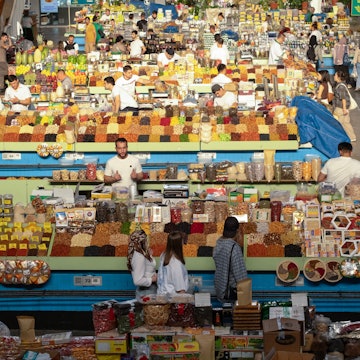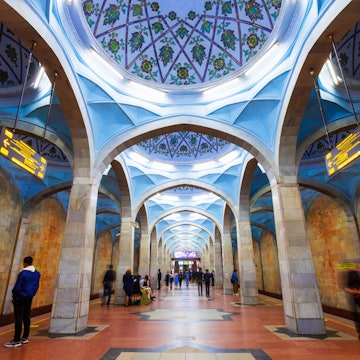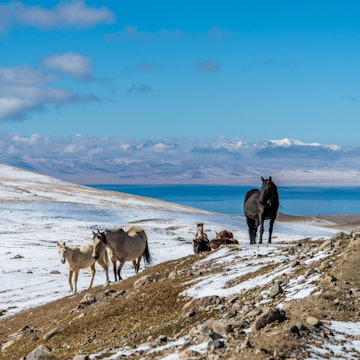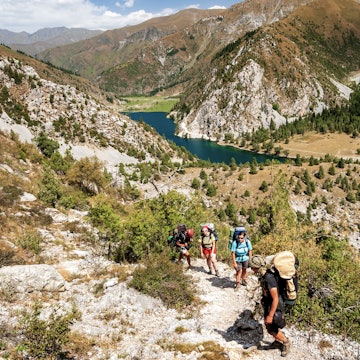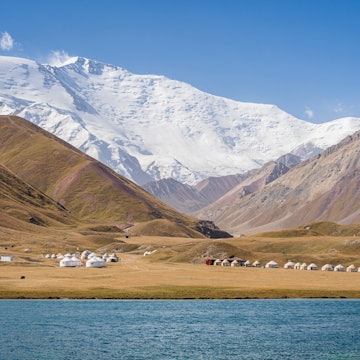

Khan’s Palace in Kokand. eranicle/Getty Images
The Fergana Valley, a fertile region in eastern Uzbekistan, is famed for its significance along the fabled Silk Road trade routes and its centuries-old artistry in silk weaving and ceramics. In bazaars and workshops in places like Margilon, Rishton and Andijon, you can still sense the ancient spirit of exchange and glimpse the living traditions that define Uzbek identity.
Sandwiched between the northern Tian Shan and the southern Gissar-Alai mountain ranges, the valley boasts pleasantly rolling landscapes and has long been considered the heartland of Uzbek culture and agriculture, mainly for its lush fields of cotton and fruit, as well as raw silk.
Today, the Fergana Valley is one of Uzbekistan's most populous and modern regions. While it may lack the glitz of Samarkand or the understated grandeur of Bukhara, the valley’s authentic charm makes it a must visit for anyone seeking to experience the soul of Uzbekistan.
When should I go to the Fergana Valley?
The best times to visit Uzbekistan's Fergana Valley are in spring (April to early June) and fall (September to November), when the weather is mild. In spring, the valley bursts to life with blooming flowers and verdant fields. Fall, on the other hand, ushers in the harvest season, offering a chance to savor the valley’s fresh fruits, such as pomegranates and melons, while enjoying cooler, more pleasant days.
The peak summer months of July and August can be challenging, as temperatures often climb above 40°C (104°F), with the dry heat making outdoor exploration uncomfortable. Similarly, winter (December to February) can be harsh, with cold temperatures and occasional snowfall.

How much time should I spend in the Fergana Valley?
In 3 days, you can explore the region’s highlights, from Kokand’s impressive Khudayar Khan Palace to Margilon’s silk heritage and Rishton’s renowned ceramics. But stretch your itinerary a couple more days to delve deeper into this enchanting region and visit lesser-known spots like Andijon, Uzbekistan’s oldest city and the historic gateway to the valley.
Is it easy to get in and around the Fergana Valley?
Trains connect the Fergana Valley’s main cities (Andijon, Margilon and Kokand) to the country’s capital, Tashkent, and an international airport. There are several trains daily, and tickets can be booked online. The train stations are clean and safe, some with small cafes and kiosks – but don’t stock up on snacks too heavily, as normally there’s a train attendant selling refreshments like non and other types of fresh bread on board.
Another way to get around is to use the local buses and taxis to explore the remote spots. Ridesharing app Yandex Go is widely used for booking a ride, but to download it, you need a local SIM card, available from Beeline or Ucell, among others.
For locating the correct bus, it is best to ask for advice at your hotel – staff members tend to speak English and are friendly and helpful. For comparison: a taxi ride of some 50 minutes from Fergana city to Rishton costs around 10 US dollars (US$) whereas a bus ticket for the same journey is US$0.60.

Top things to do in the Fergana Valley
While many of the biggest cities in the Fergana Valley are modern, an aura of centuries-old traditions lingers in the region. Visit famed ceramic masters’ workshops and traditional silk factories, see how the khans lived and taste fresh non sold at bazaars.
Explore the Silk Road craftsmanship in Rishton
Less than an hour’s drive from Fergana city delivers you to Rishton, abutting the Kyrgyzstan border. The oldest center of ceramic art in Central Asia, Rishton is renowned for its blue ceramics, a craft that local artisans have perfected over generations, using a unique natural glaze called ishkor (alkaline). Visit a traditional ceramics workshop, such as the one led by Rustam Usmanov, to learn about the art form. Other places of interest include the master Alisher Nrizov’s studio, 3km south of Usmanov’s, and the modern Rishtan International Ceramics Center, where dozens of small galleries and shops filled with ceramics line a courtyard.
See how the khans lived in Kokand
Conquered by Arabs in the 8th century, Chinggis (Genghis) Khan in the 13th, and Timur in the 14th, the Fergana Valley was ruled by the khans of Kokand from the late 18th century until it was taken by Russia in 1876. You can visit the remaining parts of Khan's Palace, an opulent structure adorned with intricate tilework and woodwork. The palace was built in 1873, and about half of it was occupied by Khudayar Khan’s harem. The harem was destroyed by the Russian army in 1919, but the rooms left intact now house the Kokand Regional Studies Museum, exhibiting an array of local artifacts, from household and military objects to black-and-white photography. The entrance fee is 15,000 Uzbek som (S) for foreign visitors (about US$1.25).

Taste the local flavors
Uzbekistan bursts with flavor, from delicious fruit to shashlyk (meat skewers), and it has a rich culinary heritage, mixing ingredients from all along the Silk Road. For the freshest samples of the famous Uzbek non, head to any of the bazaars or pick up a piece straight from a streetside tandoor-style, wood-fired clay oven. The Fergana Valley’s variation of non is katlama, a flatbread greased with butter or brushed with fermented cow’s or sheep’s milk. Plov, the ubiquitous rice dish with vegetables and meat, is also a Fergana Valley staple. The region is quite vegetarian-friendly (though some hopping from one restaurant to another may be needed), as the delicious and traditional mantu, steamed dumplings, often come with a pumpkin filling.
Tour Andijon, the historic gateway to the Fergana Valley
Located in the eastern part of the Fergana Valley, Andijon is Uzbekistan’s oldest city, with roots tracing to the 9th century. Known as the birthplace of Zahiruddin Babur, the founder of the Mughal dynasty, Andijon is a fascinating mix of history and modernity, with sleek shopping centers and restaurants mingling with traditional bazaars and tranquil medressas (Islamic academies or seminaries).
Key attractions include the Babur Literary Museum, dedicated to the life and legacy of Babur, and the Jome Mosque and Medressa, which is said to be the only building to survive the devastating 1902 earthquake. Visit the old town’s bustling Eski Bazaar near the mosque. Behind the bazaar, you’ll find a few calmer streets dedicated to handicrafts, with people forging knives and selling kitchenware and tools, or head to the Fergana Valley’s biggest bazaar, Jahon Bazaar.
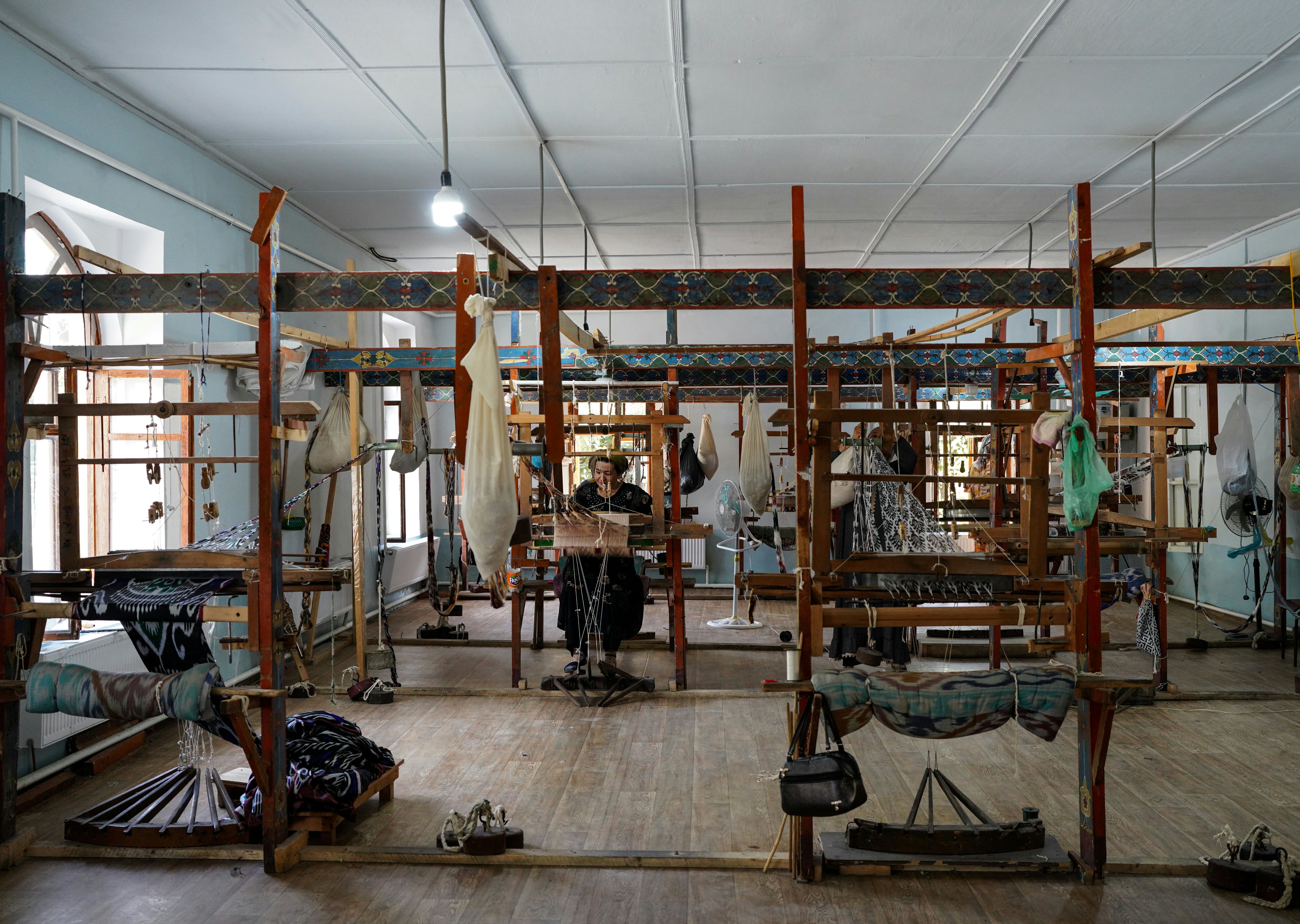
My favorite thing to do in the Fergana Valley
On my first visit to Uzbekistan, I met a group of women in Samarkand wrapped in the most dazzling scarves and clothes I had ever seen. My guide whispered respectfully that they were from Margilon, a city synonymous with fabulous silk production since the days of the Silk Road. When I later visited Margilon, my first stop was the Yodgorlik Silk Factory. On a guided tour that costs 50,000S (US$4.15) you can witness the intricate process of making khanatlas (royal silk). This is achieved with a technique called ikat, which involves separate bands of silk threads that are dyed before weaving to create the pattern. The factory also hosts a shop in a former mosque for some extraordinary shopping.
In Margilon, I also found possibly the homiest family-owned guesthouse in Uzbekistan. The Guesthouse Ikat House is located in the former home of a local artist, now run by his great great grandchildren. There are 11 rooms in two stories as well as a peaceful courtyard with pomegranate trees and a terrace on which to sip some green tea after sightseeing.
How much money do I need for the Fergana Valley?
Cash is widely used in the Fergana Valley, although some hotels and restaurants accept international credit cards. It is fairly easy to locate ATMs in bigger cities such as Andijon and Fergana, but cash always comes in handy in smaller towns and more remote spots. It is also essential when shopping and using local transportation. Budget about US$30–40 per night for a hostel or a guesthouse, while hotels are not much more expensive. You can live easily for US$50 per day while spending US$100 a day is quite extravagant.
Night in a standard room for two in a guesthouse or hotel: 400,000–550,000S (US$33–46)
Night in a room for two in an upscale hotel: 885,000S (US$74)
Public transportation ticket: 15,000S (US$1.25) for a 90km journey
Non bread: less than 6000S (US$0.50)
Upscale lunch for two in a modern restaurant: 330,000S (US$28)
Cappuccino in a modern cafe: 20,000S (US$1.70)
Is the Fergana Valley safe for travelers?
Uzbekistan is hailed as one of the safest countries for solo female travelers, and the Fergana Valley is safe to explore either alone or as part of a group. In the past, the Fergana Valley experienced some unrest, but the region has stabilized, and you’ll find yourself surrounded by extremely friendly locals. However, in bigger cities, such as Andijon, pickpocketing might occur, and the border regions are more prone to tensions, so check the authorities' advice before visiting.
What clothes should I pack?
Dress conservatively to align with local customs. All travelers should cover their shoulders, chest and knees, especially at religious sites. Men should avoid shorts and sleeveless tops, while women should avoid sleeveless tops, shorts and skirts above the knee. Women may need a headscarf when visiting religious sites – you can bring your own or borrow one at the sites. Elsewhere, you’ll notice that some women wear headscarves while others do not.
Namangan, Uzbekistan’s third most populous city and located on the northern edge of the Fergana Valley, is considered the country’s religious center. Here, you might see women mixing Islamic and Uzbek heritage in their clothing and wearing hijabs more often than elsewhere.






